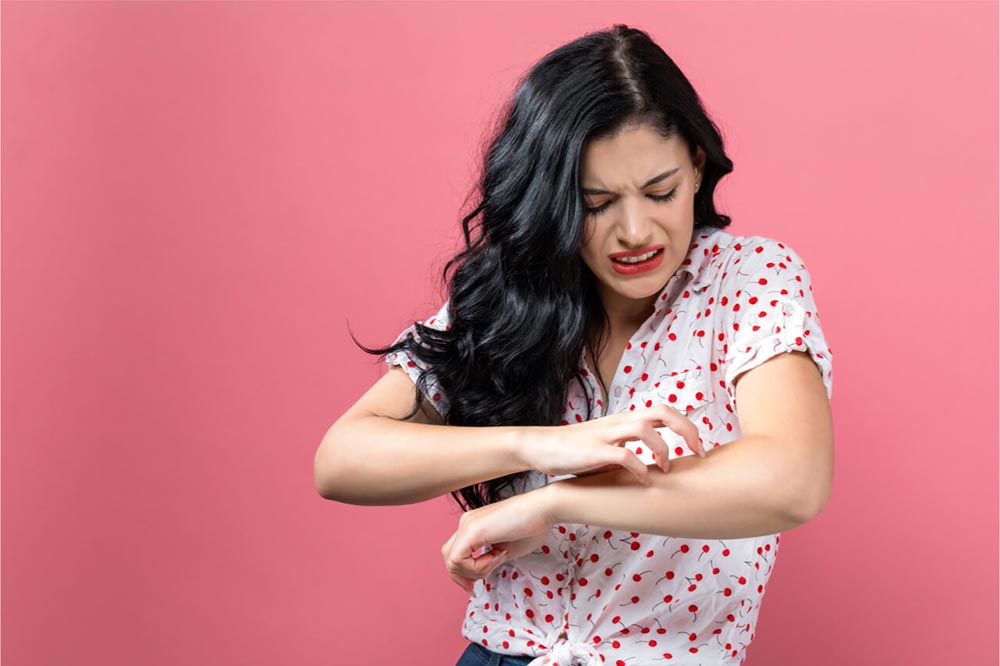Table of Contents
Nummular eczema is a coin-shaped rash on the skin that can be red, scaly, and itchy. The rash can last for several weeks or longer. It may also come back again and again. The word “nummular” means coin in Latin. This is why the disease is called “nummular,” or coin-shaped eczema.
Nummular eczema is marked by round or oval lesions on the skin, which may be red and extremely itchy. They most commonly occur on the arms, trunk, or legs, but can sometimes even appear on the face.
Causes of Nummular Eczema
The exact cause of nummular eczema isn’t known. It usually occurs in adults over 55 years old and may start with an injury to the skin such as a burn, insect bite, or cut. In some cases, nummular eczema symptoms are most severe during dry winter months and improve during warmer weather when more moisture is present in the air.
It may be triggered by an injury to the skin — like a burn, bruise, scratch or insect bite — which causes an allergic reaction. The reaction results in inflammation and an itchy rash that forms coin-shaped patches on the skin. In some cases, the rash may be triggered by an allergic reaction to metals (such as nickel), perfumes, soaps, wool or man-made fibers. Other possible triggers include:
- Exposure to extreme temperatures
- Dry air
- Stress
- Infection
Signs and Symptoms of Nummular Eczema
The most common symptoms of nummular eczema are:
- Itchy, red, dry, scaly patches on the skin that can be a few millimeters to several inches in size
- Small bumps that appear on the skin and ooze fluid when scratched
- Patches of skin that turn crusty and harden when scratched
- Oozing blisters that crust over after scratching
- Cracked or scaly skin
- Skin discoloration
How do you stop nummular eczema from spreading?
Unfortunately, there is still no sure cure for nummular eczema, but you can reduce the likelihood of spreading the infection by following these simple steps:
Stop itching. Itching the affected area will only worsen the symptoms of nummular eczema. Whenever you feel like scratching it, try to do something that will distract you from scratching your skin especially if it’s already infected. Apply topical creams. Topical creams are effective in treating nummular eczema because it contains some medicinal ingredients that help soothe the skin such as corticosteroids and coal tar extracts.
What triggers nummular eczema?
Nummular eczema is triggered by a combination of internal and external factors. The most common cause is dry skin, which can trigger the itch-scratch cycle.
Other possible triggers include:
Skin injuries. A cut or scrape can trigger nummular eczema, especially if it becomes infected with bacteria such as Staphylococcus aureus (“staph”).
Infections. A fungal infection called tinea corporis (“ringworm”) sometimes causes nummular eczema symptoms.
Allergies. Allergic reactions to metals, soaps, cosmetics, fragrances and other substances can trigger nummular eczema.
Medications. Certain drugs can trigger an allergic reaction that leads to nummular eczema, including antibiotics such as penicillin (Bicillin L-A, PC Pen VK, others) and sulfonamides (Gantanol).
How Is Nummular Eczema Diagnosed?
Your doctor will likely diagnose nummular eczema based on your medical history and a physical exam. If your doctor suspects that an infection might be causing or contributing to your nummular eczema, he or she may take a skin sample (biopsy) for testing.
To diagnose nummular eczema, your doctor will first take your medical history and give you a physical examination. They may ask questions like:
- Have you had eczema before?
- When did the rash appear?
- What does it look like?
- What are your symptoms?
Are there possible causes, like an allergen or exposure to poison ivy?
They’ll also ask about any other time you’ve had nummular eczema. A skin biopsy might be needed to confirm the diagnosis.
Treatment and Medication for Nummular Eczema
The best treatment is to prevent a flare up from happening in the first place. Here are some suggestions:
- Keep your skin moist. Use moisturizer after every bath, shower or hand washing.
- Take short baths or showers with warm — not hot — water.
- Avoid harsh soaps, especially on your hands and face.
- Apply prescription creams exactly as directed by your doctor.
- Use sunscreen when you go outdoors. If you have an allergy to sunscreens, wear protective clothing instead.

